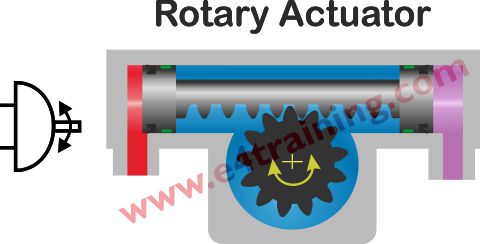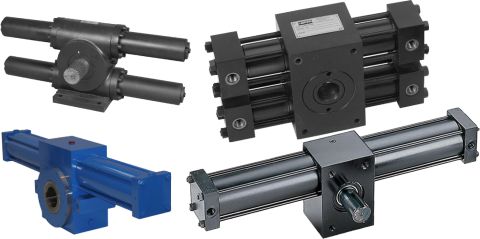What hydraulic pumps are used for
Rotary actuators are used to provide torque from hydraulic pressure. However, unlike hydraulic motors that keep turning, a rotary actuator will only turn through a limited number of rotations.
They are widely used in industrial and marine environments for applications such as clamping, tensioning, opening and closing valves or equipment, tilting or indexing etc.
How hydraulic rotary actuators work

Rack and pinion actuators utilise hydraulic cylinders to drive a horizontal rack which then rotates a gear wheel, allowing greater or less than 360 degrees of rotation, although only over a limited stroke
Vane style rotary actuators use a simple, single vane with higher pressure on one side than the other to rotate it.
Helical gear style rotary actuators use hydraulic pressure to force two helical gears against each other, therefore forcing them to rotate.
Different types of rotary actuators

There are three main types of rotary actuator, rack and pinion, vane, or helical gear. Units may utilise one or more cylinders to apply the torque.
Vane actuators: Vane actuators use vanes to create rotary motion. Vanes are small, flat plates that are attached to the actuator shaft. When hydraulic fluid is applied to the vanes, they rotate the shaft.
Rack-and-pinion actuators: Rack-and-pinion actuators use a rack and pinion to create rotary motion. The rack is a long, flat piece of metal that is attached to the actuator shaft. The pinion is a small gear that is turned by the hydraulic fluid. As the pinion turns, it rotates the rack.
Helical actuators: Helical actuators use a helical gear to create rotary motion. The helical gear is a spiral-shaped gear that is turned by the hydraulic fluid. As the helical gear turns, it rotates the actuator shaft.
Tips for operating and maintaining rotary actuators
Operating and maintaining hydraulic rotary actuators requires proper attention and care to ensure their optimal performance and longevity. Here are some essential tips to consider:
Follow manufacturer guidelines: Always refer to the manufacturer's instructions and guidelines for operating and maintaining the specific hydraulic rotary actuator model. They provide valuable information on recommended pressure limits, lubrication requirements, and maintenance intervals.
Proper fluid selection: Use the appropriate hydraulic fluid recommended by the manufacturer. Different actuators may have specific fluid requirements based on their design and operating conditions. Regularly check the fluid level and ensure it is clean and free from contaminants.
Pressure regulation: Avoid exceeding the recommended pressure limits specified by the manufacturer. Excessive pressure can lead to seal damage, leaks, or even catastrophic failure. Utilize pressure relief valves or pressure regulators to maintain safe and controlled operation.
Regular inspections: Perform routine visual inspections of the actuator, including seals, connections, and mounting brackets. Look for signs of leakage, corrosion, or wear. Address any issues promptly to prevent further damage.
Lubrication: Follow the manufacturer's guidelines for lubricating the actuator. Lubrication helps reduce friction and wear, ensuring smooth operation. Use the recommended lubricants and apply them at the specified intervals.
Seal maintenance: Seals play a crucial role in preventing fluid leaks and maintaining the actuator's performance. Inspect seals regularly for wear, cracking, or signs of leakage. Replace damaged seals promptly to avoid further damage to the actuator.
Avoid contamination: Keep the hydraulic system clean and free from contaminants such as dirt, debris, and moisture. Use filters and strainers to remove particles from the hydraulic fluid and ensure that the system remains clean.
Regular maintenance schedule: Implement a maintenance schedule that includes routine checks, fluid changes, and seal replacements as necessary. Adhere to the schedule to prevent unexpected failures and extend the lifespan of the actuator
Training and expertise: Ensure that operators and maintenance personnel receive proper training on the operation and maintenance of hydraulic rotary actuators. Familiarity with the equipment and its correct handling can minimize errors and prevent avoidable damage.
Safety precautions: Always prioritize safety when operating and maintaining hydraulic rotary actuators. Follow appropriate lockout/tagout procedures, wear personal protective equipment, and exercise caution around pressurized systems.
By following these tips, you can optimize the performance and reliability of hydraulic rotary actuators, minimizing downtime and maximizing their lifespan.
How to specify rotary actuators
Specifying hydraulic rotary actuators requires careful consideration of various factors to ensure the actuator meets the specific requirements of the application. Here are the key steps to follow:
Determine the operating parameters: Start by identifying the key operating parameters such as the required torque, rotational speed, and operating pressure. Consider the load characteristics, cycle times, and any environmental factors that may affect the actuator's performance.
Assess space and mounting requirements: Evaluate the available space and mounting options in the system. Consider factors such as the actuator's dimensions, mounting configuration (flange, foot, or clevis), and the required rotation angle.
Select the appropriate size and type: Based on the torque and speed requirements, choose an actuator with the appropriate size and type. Consider factors such as the piston diameter, cylinder length, and gear or spline design. Ensure that the actuator's torque capacity and speed capabilities align with the application's demands.
Consider operating conditions: Evaluate the specific operating conditions the actuator will be subjected to. Take into account factors such as temperature, humidity, vibration, shock, and potential exposure to chemicals or contaminants. Specify an actuator that is designed to withstand these conditions.
Determine control options: Decide on the control options required for the actuator. This may include manual control, on/off control, proportional control, or even computer-based control systems. Consider the compatibility of the actuator with the chosen control method.
Check mounting and interface compatibility: Ensure that the actuator is compatible with the mounting and interface requirements of the system. Verify the mounting hole patterns, shaft dimensions, and connection options to ensure proper integration with other components.
Verify hydraulic fluid requirements: Consider the type of hydraulic fluid required for the actuator. Check the viscosity, temperature range, and compatibility with the actuator's seals and materials. Ensure that the chosen actuator can handle the specified hydraulic fluid.
Review certifications and standards: If applicable, consider any industry-specific certifications or standards that the actuator needs to comply with. Examples include ISO, ANSI, or specific safety certifications.
Seek expert advice if needed: If you are uncertain about the specifications or have complex requirements, it may be helpful to consult with hydraulic system experts or actuator manufacturers. They can provide valuable insights and guidance to ensure the correct specification of the actuator.
Design tips, techniques and potential issues
Hydraulic rotary actuators are a reliable and efficient way to create rotary motion. However, like any mechanical device, they can experience problems. Some potential issues are:
Leaks: Hydraulic fluid leaks can cause a number of problems, including reduced performance, decreased efficiency, and increased wear. Leaks can be caused by damaged seals, hoses, or fittings.
Contamination: Contamination of the hydraulic fluid can also cause problems, such as reduced performance, decreased efficiency, and increased wear. Contamination can be caused by dirt, debris, or moisture.
Overheating: Overheating can damage the actuator and shorten its lifespan. Overheating can be caused by excessive torque, high ambient temperatures, or inadequate cooling.
Mechanical failure: Mechanical failure can occur due to a number of factors, such as fatigue, wear, or improper installation. Mechanical failure can cause the actuator to stop working or to operate incorrectly.
Air pressure venting: Complications can arise because when the hydraulic fluid may be sealed against atmosphere, as in a rod seal, rather than more fluid, as in a bore seal. This increases the risk of contamination and environmental seal damage. Carefully check the area where the rack and pinion are located. If this is enclosed but has a positive area change, then there will be air transfer with the atmosphere outside which runs the risk of drawing in new contaminants that may not be able to escape.
Cross contamination: If the actuator is used to operate a valve containing another fluid then the risk of cross-contamination must be considered and the inclusion of tale-tale holes to see any leakage should be considered.